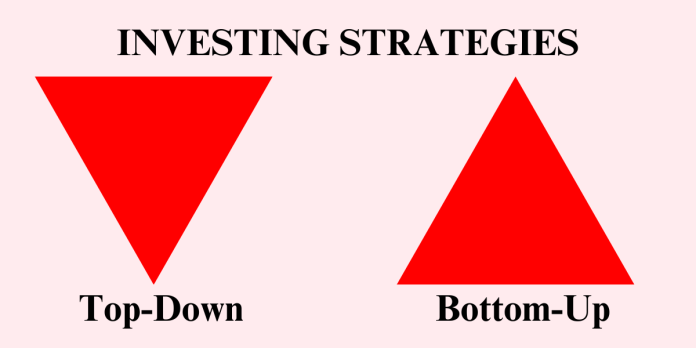In the vast landscape of investment strategies, two predominant paths beckon the discerning investor: the “bottom up” and the “top down” approaches. Each unveils its own set of virtues, yet neither claims superiority over the other. Rather, within these broad categories lie various methodologies that cater to distinct investor preferences. Today, we delve into the dichotomy of “Bottom Up” versus “Top Down” investing, exploring the nuances and potential pitfalls that accompany each route. Moreover, we unveil the power of adopting a hybrid approach, marrying elements of both to optimize your investment endeavors.
Deciphering “Bottom Up” and “Top Down” Investing
Understanding these two fundamental approaches requires a more abstract perspective. Picture it as a choice between the “macro” and the “micro” viewpoints. Are you looking at the bigger picture first, analyzing macroeconomic trends, and then zooming in on individual stocks? Or do you begin with the intricate details of a company, evaluating its financials, competitive advantage, and management quality before considering broader themes?
Embarking on the “Top Down” Journey
The “top down” approach, once chosen, unfolds into different avenues:
– Observing macroeconomic developments and subsequently selecting stocks.
– Extracting insights from big-picture statistics to make informed stock choices.
Interestingly, a rising trend in macro-focused investors leans towards utilizing industry ETFs for targeted exposure, treating the portfolio as an exercise in strategic asset allocation that adapts to macroeconomic shifts.
Read: Decoding Macroeconomic Data
Delving into “Bottom Up” Analysis
Conversely, the “bottom up” investor commences the journey at the company level, scrutinizing factors like:
– Company financials.
– Competitive advantage.
– Management quality.
Despite their seemingly opposing nature, both approaches don’t necessitate exclusive commitment. Instead, the distinction lies in where an investor chooses to initiate their analysis and the weight assigned to each aspect in the final decision-making process.
Unraveling the Threads of Top Down Investing in Stock Analysis
The “big picture statistics” essence of top-down investing often finds favor in growth investing circles. Renowned figures like Professor Damodaran advocate for this approach, especially when evaluating early-stage, high-growth stocks lacking substantial historical data. By projecting a Total Addressable Market (TAM) and determining a rational growth path, analysts can estimate growth rates for Discounted Cash Flow (DCF) valuation models.
On the flip side, a bottom-up approach grounds itself in a stock’s historical fundamentals to project future growth rates. The top-down investor, however, relies on macroeconomic data, market share, margin improvements, or a combination to discern likely growth drivers.
Navigating the Pitfalls: Recency Bias and Cyclical Industries
- Recency Bias: The rearview mirror clarity versus windshield uncertainty, as eloquently put by Warren Buffett, warns against getting entangled in past data. Both bottom-up and top-down investors risk projecting unrealistic future growth rates if swayed by recent trends instead of considering the complete business cycle.
- Cyclical Industries: Overreliance on recent data can distort valuations, particularly in cyclical industries. Damodaran’s wisdom advocates evaluating cyclical industries over entire business cycles to establish accurate long-term valuations.
Avoiding Pitfalls: Underestimating Powerful Businesses and Overly Optimistic Research Reports
- Underestimating Powerful Businesses: Averaging data across large groups can be misleading. Exceptional companies can outperform even in low-growth industries by innovating, expanding horizontally or vertically, or offering essential products that defy market conditions.
- Overly Optimistic Research Reports: Bright industry projections can lead investors astray, especially in dynamic sectors like tech. The dot-com crash serves as a stark reminder of the perils associated with blindly trusting overly optimistic forecasts from reputable firms.
Crafting a Hybrid Approach for Long-Term Success
In the face of these pitfalls, a pragmatic solution emerges: a hybrid approach. By combining elements of both top-down and bottom-up analysis and incorporating a margin of safety on assumptions, investors can navigate the complexities of fundamental analysis with greater resilience.
Investor Takeaway: Balancing Act for Long-Term Prosperity
In the intricate dance of top-down and bottom-up investing, there’s no one-size-fits-all solution. Your unique investing temperament should guide your choice, and experimenting with different aspects of both approaches can unveil what aligns with your preferences. Focus on maintaining a margin of safety, and let the magic of compounding flourish over the long term. The key lies in the artful fusion of both worlds, creating a personalized strategy that stands the test of time. Happy investing!
Know More:


